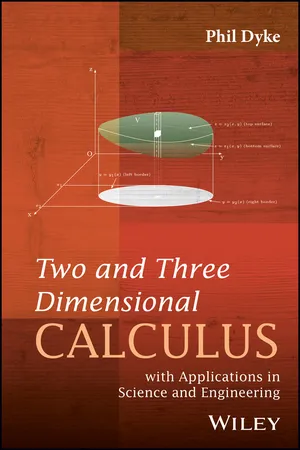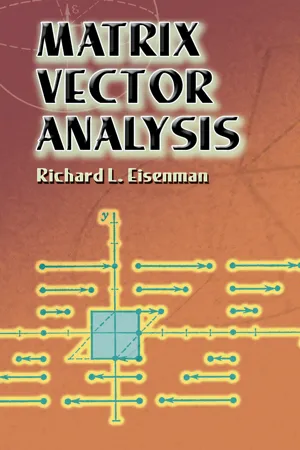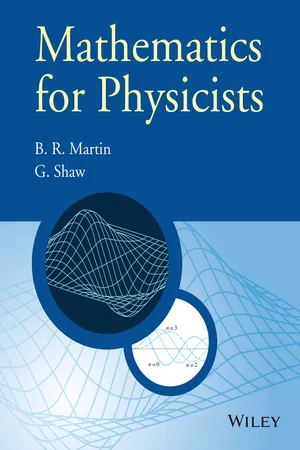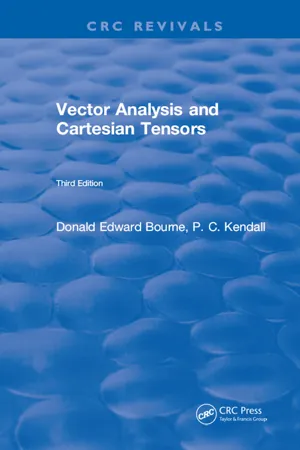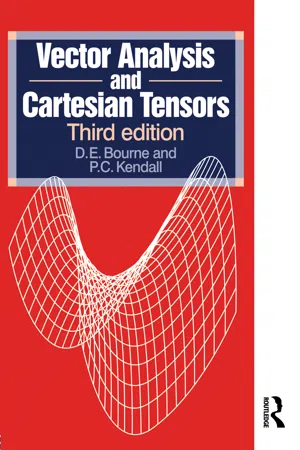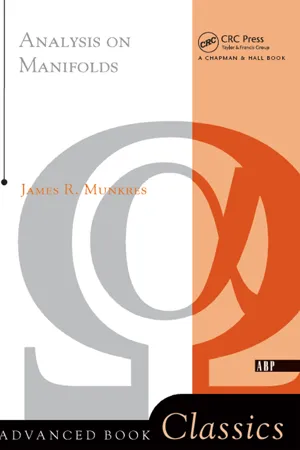Physics
Stokes Theorem
Stokes' theorem is a fundamental theorem in vector calculus that relates the surface integral of the curl of a vector field to the line integral of the vector field around the boundary curve. It states that the circulation of a vector field around a closed curve is equal to the flux of the curl of the vector field through any surface bounded by the curve.
Written by Perlego with AI-assistance
Related key terms
6 Key excerpts on "Stokes Theorem"
- eBook - ePub
Two and Three Dimensional Calculus
with Applications in Science and Engineering
- Phil Dyke(Author)
- 2018(Publication Date)
- Wiley(Publisher)
To resolve this, a common-sense approach is used. The theorems are stated and proved in a way to show, it is hoped, what is going on. Once this understanding is established then there follows arguments that show how the theorems are extended. Finally, the derived relationships are applied to practical problems. Let us start with the relationship between surface and path integrals, called Green's theorem in the plane in Chapter 10 which is now generalised. 11.2 Stokes' Theorem The starting point for Stokes' theorem is to restate Green's theorem in the plane: The first task is to write this in vectorial terms. Defining, then gives The integrand on the right-hand side can be written and is the element of the flat rectangular region in the plane, so Green's theorem in the plane can be written: 11.1 Changing this slightly to with where now is a curved surface, as if made of thin flexible plastic then hardened, and and are curvilinear co-ordinates with the first two unit vectors embedded in. Equation 11.1 now reads exactly the same but is now more general and is termed Stokes' theorem. This is an example of a co-ordinate-free equation derived in a particular way that because it now is free of the co-ordinates, immediately generalises. It does however warrant a proof. Here it is as a formal theorem. Theorem (Stokes' Theorem) For an orientable surface with a bounding curve and vector field continuous and differentiable on, it is true that Proof There are many ways to approach the proof of Stokes' theorem. Pure mathematicians couch the theorem in general terms and the proof then needs knowledge of such esoteric topological concepts as compact manifolds and de Rham cohomologies. This is unsuitable here, as is the slick, few-line proof using tensors. Some are quite content to believe the truth of Stokes' theorem based on the preliminary vectorisation of Green's theorem in the plane, Equation 11.1 - eBook - ePub
- Richard L. Eisenman(Author)
- 2013(Publication Date)
- Dover Publications(Publisher)
[2]. We will show how Stokes’ theorem transforms this Faraday law into one of Maxwell’s fundamental equations. If we combine[1]and[2], Faraday’s law becomes . This equates a line integral and a surface integral, and we may appeal to the Stokes Theorem to put the two on common ground. Apply the Stokes Theorem to get . (Note that it is not convenient to apply the Stokes Theorem to the right side of[3]because[5].) Substituting[4]in[3]gives . Since this relation must hold regardless of the surface selected, the integrand itself in[6]must be zero; i.e.,[7]. This statement is one of[8]equations.EXERCISE [38]:The Divergence theorem in fluid flow. Here we intend to show how conservation of mass and the Divergence theorem lead to the basic law of continuity in fluid flow. The vocabulary required is the velocity , whose dimensions are[1], and the density ρ, whose dimensions are[2]. Then the quantity has dimensions[3]and measures the net loss of mass per unit of time through the surface σ. On the other hand, the volume integral of the time rate of change of density, in symbols[4], measures the net gain in mass per unit of time from the volume bounded by the surface. According to conservation of mass, the gain should be[5]the loss so that . Here a surface integral and a volume integral are equated, and we may use a transformation theorem, namely[7], to put them on common ground. It would be difficult to transform the volume integral to a surface integral because[8]. Thus we apply the Divergence theorem to . Now, combining, . This integral must be zero no matter what volume is selected, so the integrand itself must be zero, whence we have the celebrated law of continuity,[11] - eBook - ePub
- Brian R. Martin, Graham Shaw(Authors)
- 2015(Publication Date)
- Wiley(Publisher)
the circulation of V around the loop C. Thus the theorem states that the surface integral of is equal to the circulation of V around the bounding curve C. This is closely related to the interpretation of curl. To see this, we apply (12.68) to a loop C that encloses a small surface element, which shrinks to a point when d s → 0. In this limit, the variation of V and can be neglected on d s, so that the left-hand side of (12.68) becomes, implying (12.69) In other words, at a point r is the circulation per unit area around the boundary of an infinitesimal surface d s containing the point r. For example, let us again consider a vector field V = ρ v, where ρ is the density and v is the velocity field of a fluid. Then for a uniform flow pattern, such as that shown in Figure 12.12 a, and V is said to be irrotational. On the other hand, at the centre of a vortex, like that shown in Figure 12.12 b, clearly. It is also non-zero in a non-uniform parallel motion, as shown in Figure 12.12 c, since the velocities on either side of a point are different. Essentially, when there is rotational motion in addition to, or opposed to, translational motion. A practical viewpoint is to consider what would happen if one inserted a small ‘paddle wheel’, which is free to rotate about its axis. In the flow pattern of Figure 12.12 a, where, it would not rotate: the motion is irrotational. In Figures 12.12 b and 12.12 c, where, it would rotate. Figure 12.12 Flow of a fluid. The coloured lines are the flow lines; the arrows show the direction of the vector field V. Their lengths show the relative magnitudes of V. In the rest of this section we will first derive Stokes' theorem, and then consider some applications. 12.4.1 Proof of Stokes' theorem We start by considering a closed curve C surrounding a plane surface S parallel to the x–y plane, so that z is constant. Then and But by Green's theorem in the plane (11.20), we have so that (12.70) where, a unit vector in the z- direction - eBook - ePub
Vector Analysis and Cartesian Tensors
Third Edition
- Donald Edward Bourne(Author)
- 2018(Publication Date)
- Chapman and Hall/CRC(Publisher)
Integral theorems 6 6.1 INTRODUCTIONIn Chapter 4 , scalar and vector fields were defined and the properties of gradient, divergence, and curl were discussed; and in Chapter 5 we were concerned with various integrals of scalar and vector fields, and the techniques whereby such integrals are evaluated. The ground has thus been prepared for the two central theorems in vector analysis: (i) the divergence theorem (also called Gauss’s theorem), which relates the integral of a vector field F over a closed surface S to the volume integral of div F over the region bounded by S; and (ii) Stokes’s theorem which relates the integral of a vector field F around a closed curve C to the integral of curl F over any open surface S bounded by C . In this chapter we shall prove these theorems and some related results.6.2 THE DIVERGENCE THEOREM (GAUSS’S THEOREM) Definitions1. A simple closed surface S is said to be convex if any straight line meeting it does so in at most two points.2. A simple closed surface S will be called a semi-convex surface if axes Oxyz can be so chosen that any line drawn parallel to one of the axes and meeting S either (i) does so in just one or just two points, or (ii) has a portion of finite length in common with S.The divergence theoremA closed region V is bounded by a simple closed surface S. If the vector field F is defined and continuously differentiable throughout V, then
Proof=∬ SF. d S∭ Vdiv F d V .(6.1) The result will first be proved, in part (a), for a region V bounded by a convex surface S. The theorem will then be extended to more general regions in parts (b), (c) and (d).(a) Take rectangular axes Oxyz and denote by R the projection of S on to the xy-plane. Divide S into upper and lower parts, SU and SL , as viewed from R (Fig. 6.1 ). Let a line drawn parallel to Oz from a point in R cut SL at P and SU at Q, and denote the z-coordinates of P, Q by zP , zQ (zP < zQ ). All points (x, y, z) in V are covered if x and y range over all values in R and the corresponding values of z range from zP to zQ - P C Kendall(Author)
- 2017(Publication Date)
- Routledge(Publisher)
6 Integral theorems6.1 INTRODUCTION
In Chapter 4 , scalar and vector fields were defined and the properties of gradient, divergence, and curl were discussed; and in Chapter 5 we were concerned with various integrals of scalar and vector fields, and the techniques whereby such integrals are evaluated. The ground has thus been prepared for the two central theorems in vector analysis: (i) the divergence theorem (also called Gauss’s theorem ), which relates the integral of a vector field F over a closed surface S to the volume integral of div F over the region bounded by S ; and (ii) Stokes’s theorem which relates the integral of a vector field F around a closed curve to the integral of curl F over any open surface S bounded by . In this chapter we shall prove these theorems and some related results.6.2 The Divergence Theorem (Gauss’s Theorem)
Definitions
1. A simple closed surface S is said to be convex if any straight line meeting it does so in at most two points.2. A simple closed surface S will be called a semi-convex surface if axes Oxyz can be so chosen that any line drawn parallel to one of the axes and meeting S either (i) does so in just one or just two points, or (ii) has a portion of finite length in common with S .The divergence theoremA closed region V is bounded by a simple closed surface S . If the vector field F is defined and continuously differentiable throughout V , thenProof∬ sF.dS =∭ vdiv F d V . ( 6.1 )The result will first be proved, in part (a), for a region V bounded by a convex surface S . The theorem will then be extended to more general regions in parts (b), (c) and (d).(a) Take rectangular axes Oxyz and denote by ℜ the projection of S on to the xy -plane. Divide S into upper and lower parts,SUandSL, as viewed from ℜ (Fig. 6.1 ). Let a line drawn parallel to Oz from a point in ℜ cutSLat P andSUat Q , and denote the z -coordinates of P, Q byZp , ZQ (zP <zQ ). All points (x, y, z ) in V are covered if x and y range over all values in ℜ and the corresponding values of z range fromzPtozQ- eBook - ePub
- James R. Munkres(Author)
- 2018(Publication Date)
- CRC Press(Publisher)
7 Stokes’ TheoremWe saw in the last chapter how k-forms provide a generalization to ℝnof the notions of scalar and vector fields in ℝ3 , and how the differential operator d provides a generalization of the operators grad, curl, and div. Now we define the integral of a k-form over a k-manifold; this concept provides a generalization to ℝnof the notions of line and surface integrals in ℝ3 . Just as line and surface integrals are involved in the statements of the classical Stokes’ theorem and divergence theorem in ℝ3 , so are integrals of k-forms over k-manifolds involved in the generalized version of these theorems.We recall here our convention that all manifolds, forms, vector fields, and scalar fields are assumed to be of class C∞ .§33. INTEGRATING FORMS OVER PARAMETRIZED-MANIFOLDIn Chapter 5 , we defined the integral of a scalar function f over a manifold, with respect to volume. We follow a similar procedure here in defining the integral of a form of order k over a manifold of dimension k. We begin with parametrized-manifolds.First let us consider a special case.Definition. Let A be an open set in ℝk; let η be a k-form defined in A. Then η can be written uniquely in the formη = f dx 1∧ ⋯ ∧ dx k.We define the integral of η over A by the equationprovided the latter integral exists.∫ Aη =∫ Af ,This definition seems to be coordinate-dependent; in order to define ∫Aη, we expressed η in terms of the standard elementary 1-forms dxi, which depend on the choice of the standard basis e1 , …, ekin ℝk. One can, however, formulate the definition in a coordinate-free fashion. Specifically, if a1 , …, akis any right-handed orthonormal basis for ℝk
Learn about this page
Index pages curate the most relevant extracts from our library of academic textbooks. They’ve been created using an in-house natural language model (NLM), each adding context and meaning to key research topics.
